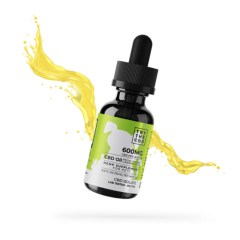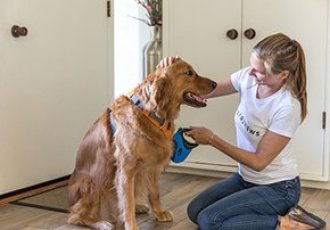BestReviews is reader-supported and may earn an affiliate commission. Details

With a lab-tested formula and full spectrum of CBD, this oil provides strong relief without any adverse side effects.
With a lab-tested formula and full spectrum of CBD, this oil provides strong relief without any adverse side effects.
The organic composition contains coconut oil and hemp extract, as well as naturally occurring terpenes, for relief. Designed with corndog flavoring to keep pets interested in the smell. Each bottle comes with 30 servings, allowing for long-lasting usage.
Effects may go down after a period of time.

This selection delivers a tasty dose of anxiety-relieving peanut butter to your dog without sacrificing safety.
This selection delivers a tasty dose of anxiety-relieving peanut butter to your dog without sacrificing safety.
Composed of all-natural ingredients, including organic hemp oil, dry roasted peanuts, and salt to further security. Contains no unnecessary amounts of sugar. A great choice for hyperactive or stressed dogs. Works as a pain reliever by cooling down nervous aches and discomforts.
Owners will have to monitor closely how much peanut butter their dog consumes.

With completely natural products, simply apply a few drops of this oil to quickly and smoothly help your dog.
With completely natural products, simply apply a few drops of this oil to quickly and smoothly help your dog.
Naturally calms down dogs in the period of 1 hour through the full spectrum of hemp oils. Designed with chamomile, an ingredient known to lift moods and brain function. Choose the number of drops based on the size of your dog.
Effects don't last as long as some hoped.

These oils require no swallowing as they are absorbed within the mouth itself, so there is no effort required from your cat.
These oils require no swallowing as they are absorbed within the mouth itself, so there is no effort required from your cat.
Simply place a few drops on your cat's tongue in order to apply and experience the effects of this CBD oil. An excellent choice for chronic anxiety or for more stressful situations, such as traveling or large crowds. Composed of non-toxic materials, so it is natural and safe.
May require higher dosages after some time.

For dogs that are continuously stressed out, these treats offer quick and relaxing effects that they will enjoy.
For dogs that are continuously stressed out, these treats offer quick and relaxing effects that they will enjoy.
Offers typical spectrums of CBD, as well as infused extracts from natural chamomile, passionflower, and valerian root that dogs will enjoy. Effects last for long periods of time, even for larger-sized dogs. Can be used in stressful situations or on a regular basis.
May be too large, especially for smaller pets.

We recommend these products based on an intensive research process that's designed to cut through the noise and find the top products in this space. Guided by experts, we spend hours looking into the factors that matter, to bring you these selections.

Just like humans, dogs can suffer from anxiety. A number of factors may contribute to a dog’s anxiety; what makes it all the more saddening is the fact that they can’t verbally communicate their fears and problems to their humans. Moreover, you can’t explain to them that they’ll be all right.
A dog’s anxiety may be minor and infrequent or powerful and debilitating. The causes vary as much as the dogs themselves. Life on the street or in a shelter can negatively affect dogs, especially if they were abandoned or had negative experiences with neglectful or abusive people. New and unfamiliar experiences — busy streets, loud noises like fireworks — can cause great distress, too.
A variety of treatments and calming methods exist for dogs with anxiety, and they’re worth exploring. At BestReviews, we love our pooches and are glad to know there are ways to help dogs cope. In this guide, we discuss what you can do to help your dog live his best life.

It’s worth understanding the common types of canine anxiety in order to better support your dog. Treatments should be used to alleviate stress, while proper training can help lessen or eliminate the anxiety.
Some dogs become afraid when left alone. This could be due to unfamiliarity, past trauma, or another reason. Separation anxiety can be marked by barking, destructive behavior, or accidents in the house.
Dogs who have spent time in a shelter may have issues with abandonment and unpredictability. They may have experienced trauma, which may or may not be known by shelter workers. Dogs with shelter anxiety may frequently be on edge. Cowering, trembling, pacing, and excessive panting and drooling are among the signs.
Based on past experiences or simply the unknown, dogs can be fearful of people, situations, and other stimulants. Some fears are harder to overcome than others, and some may never be relieved completely. Canine fear can be as localized as a loud appliance in the home or as widespread as the sights and sounds of cars through the window. Barking, cowering, and fleeing are signs of canine fear.
As dogs grow older, they may develop ailments or other deficiencies. These physical and mental issues can lead to anxiety, as the dog may not be aware of what is going on. They know something is different, maybe even dangerous, but they don’t understand what it is. This can lead to fear, anxiety, and stress. Excessive pacing, panting, drooling, and accidents in the home are some of the signs.
Just like people, some dogs are generally stressed and anxious. Regularly, comprehensive treatment is required to help them calm down, though the anxiety is likely never to dissipate completely.

Dog treats can be used in a variety of ways to combat stress. Some treats specifically target fear and anxiety and include calming properties to help dogs relax. These can be given both during and before stress-inducing events, such as fireworks or travel.
Giving treats is also a good way to distract and alter behavior. Your dog may associate receiving treats with a positive action, such as sitting. During a stressful situation, try asking your dog to perform a positive behavior. Then, reward him. This experience can help change his reaction to the stress inducer.
Certain oils and aromas can help calm your dog’s nerves. These may come in the form of an essential oil you diffuse or a mist you spray near your dog's bed and toys. Some oils, like CBD or rescue remedies, come in the form of drops. These may be administered directly to your dog to help him relax.
While a lot of essential oils can benefit humans, oils or sprays you use around your dog must be safe for pets and made directly for their use. Some essential oils are harmful to dogs when ingested or absorbed through the skin. Others, such as eucalyptus and tea tree oil, are poisonous to dogs when released into the air.
The sensation of physical pressure can be a calming, protective influence on dogs. Many enjoy weighted devices that help them feel focused and safe. The weighted blankets that some humans love might not be quite right for dogs, but you can shop for a weighted dog jacket that straps onto your pooch like a coat. These are good for home use and should only be worn under your supervision.
Some dogs may be calmed by watching TV or listening to music. This can be used for dogs with separation anxiety as a way to help prevent them from feeling lonely. In fact, there are apps and TV channels that play entertainment designed specifically for dogs.
There are many effective ways of relieving your dog’s anxiety through medication. If your non-medicinal treatments aren’t working, or if your dog’s anxiety is severe, consult your veterinarian.

Dog treats: Pawstruck Dog Jerky Treats
Treats are a great way to reward positive behavior, particularly as a dog gets over his anxiety. We like these all-natural and healthy jerky treats from Pawstruck.
Dog toy: Kong Wobbler
Keeping dogs active and presenting them with challenges and distractions helps ease and prevent anxiety. This Kong toy makes obtaining treats a worthy test.
Dog camera: Pawbo + Pet Camera
Monitor your dog when you’re away with a camera. It’ll help you identify signs of stress or anxiety that you may need to address. This one from Pawbo has a 130-degree lens and a two-way microphone, and it dispenses treats.
Dog bed: Big Barker Waterproof Dog Bed
Every dog needs a place to rest, relax, and take refuge. A dog bed like this orthopedic option from Big Barker provides safety and calm when fear and anxiety strike.
Inexpensive: For under $15, you can find a variety of calming treats of various flavors for your dog. Some oils in smaller sizes may also be available in this range.
Mid-range: For $15 to $30, you’ll find more treats in larger quantities as well as some calming oils designed for dogs.
Expensive: Over $30, you enter the realm of anxiety jackets and vests for dogs. The larger your dog is, the costlier the jacket will likely be. In this range, you can also purchase calming treats and oils in larger quantities.
Plan ahead. Knowing your dog’s stressors is the first step to fighting them. Try to anticipate when your dog might need anxiety relief before the trigger occurs. If you have anxiety treatments ready to go ahead of time, you may be able to save your dog (and yourself) some stress.
Create a familiar environment. Craft a comfortable space for your dog. A special bed, blankets, and toys can be soothing, especially if your scent is on them. These items can help your pup feel at peace during stressful situations.
Never punish anxiety. Don’t yell, scold, or punish your dog for being fearful or stressed. It’ll only make the anxiety worse. Instead, work to distract, redirect, and calm your canine friend.
Consult a vet. If your dog’s anxiety continues or grows, it’s worth talking to a vet, especially if the anxiety has recently arisen. Your dog may be trying to tell you something is wrong.

Q. What’s the best way to prevent anxiety from occurring?
A. Eating quality food and exercising regularly go a long way toward helping a dog enjoy a happy life. Maintaining a routine is also an important factor, as some dogs do not feel comfortable in unfamiliar situations. Lastly, socialization is important. Introducing your dog to other dogs, people, and environments can provide your canine companion with emotional and social stimulation. Make sure that introductions are done gradually so as not to surprise or overwhelm your dog.
Q. What’s the best method for fighting anxiety?
A.You’ll need to invest time and energy in identifying and tracking your dog’s anxiety, learning about triggers, responses, and positive results. Dogs not only respond to situations differently, they also respond to treatments differently. Work to prevent or avoid stressful situations, but be prepared for them when they occur.
Q. Are any treatments harmful?
A. Individual dogs react differently to treatment. Some may require a multi-pronged approach, while others may find relief instantly. Be particularly cautious with oils and lotions, as some dogs are sensitive to them — and as we mentioned, some oils for humans are toxic to dogs. Also, for safety’s sake, avoid leaving your dog alone while he’s wearing a heavy coat or collar.
Get emails you’ll love.
Learn about the products you’re wondering if you should buy and get advice on using your latest purchases.
